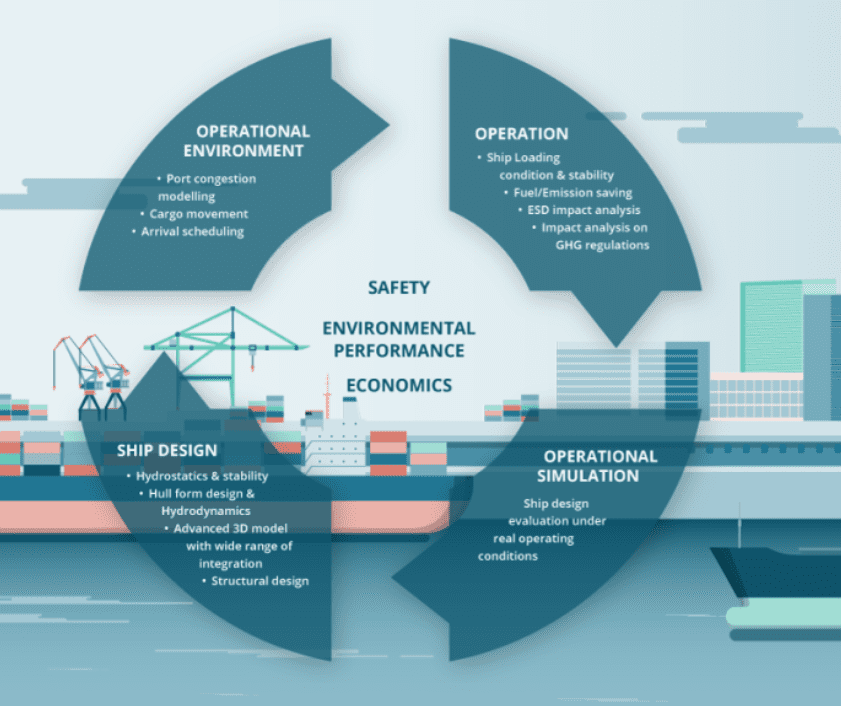May 28, 2024
A “studio” approach to solving shipping’s decarbonization challenges
Imagine a music studio on Abbey Road, with a prodigious drummer, bassist, singer, guitarist, and pianist all putting their genius together to create a new hit that will top global charts. Now, what if we could apply the same creative and collaborative recipe to solve some of shipping’s biggest challenges? This is what NAPA Studios has set out to achieve.
In place of musicians, NAPA Studios brings together shipowners, charterers, shipyards, classification societies, financiers, and insurers. But very much like a band, they will contribute their diverse expertise to create something unique: innovative solutions to some of the most imminent challenges faced by the maritime industry today.

A fresh approach is needed because of the magnitude of the changes required of the maritime industry and the accelerated pace at which they must happen. In short, we must create new ships powered by alternative energy sources, but also select the right systems for every vessel in an incredibly diverse global fleet. Beyond technology choices, it is the entire operational ecosystem that will be transformed to enable net-zero shipping: from safeguards to ensure the safe use of new fuels and technologies, to cost-sharing mechanisms and contractual frameworks fit for decarbonized shipping.
None of these challenges can be solved by one technology or organization alone. Instead, successfully navigating these issues will require a step change in the way the maritime industry operates, demanding closer and enhanced collaboration. But for such cooperation to happen in practice, it requires trust and transparency, which is built on the foundations of digital technology. This is where NAPA Studios can make a meaningful difference.
Connecting the dots
What does this look like in practice? The nature of projects undertaken by NAPA Studios will be as varied as music genres. Still, they will have one thing in common: they will leverage NAPA’s advanced software, performance models, and experience with digital twins, data science and simulation tools to create new insights and solutions. This will bring together expertise from a wide network of maritime stakeholders to foster partnerships ranging from ship design to operations, all with digital systems at their core. If project partners are the artists, data is the beat.
Some collaborations will aim to provide more clarity on the practical implications of deploying new technologies, such as wind propulsion. This will build on the success of our recent simulation study with Norsepower and Sumitomo, which evaluated the benefits of combining wind propulsion and voyage optimization, finding potential emissions reductions of up to 28% on average.
Other ongoing projects are looking at advancing the use of digital twins from design to operations, to boost the safety, efficiency and environmental footprint of shipping. In tangible terms, this would enable owners to use ship-specific design data to improve operational efficiency and ship maintenance, while also allowing operational data to be fed back to shipyards to improve future designs. This would mark a breakthrough in data sharing, with new business models between shipyards and owners that could have a transformative effect in accelerating emissions reductions as well as the development of more energy-efficient designs.
Another area of work will be developing the new operational frameworks needed for the transition to net zero. As illustrated by Blue Visby, which is underpinned by NAPA’s technology, solid digital platforms that are trusted by all parties can help align all stakeholders behind shared goals. By bringing all parties involved in a voyage onboard new contractual frameworks and sharing mechanisms, we can tackle split incentives and accelerate emissions reductions.
Moreover, NAPA Studios will work directly with individual shipyards, shipowners, charterers, and other supply chain stakeholders in tailored projects that will use data analysis and simulation tools to solve practical problems. This could, for example, help shipowners assess their fleet’s environmental performance and model the emissions, safety and operational impacts of installing new technologies on their specific vessels. A recent example of such an approach was our joint study with ClassNK and shipowner Marubeni, which used NAPA’s ship performance model and voyage simulation tools to measure the impact of voyage optimization on the GHG emissions and CII ratings of a real-life fleet. The study found 7.3% potential reductions, enough to enable vessels to maintain their CII rating for an additional two to three years.
While there’s no silver bullet solution for shipping’s decarbonization, NAPA Studios provides a source of impartial expertise and verified insights to help map out the right approach for each organization’s sustainability strategy.
Our vision is that by responding to shipping’s growing demand for data-based evidence and proven solutions for every aspect of the huge transformation ahead, we can contribute to the whole industry’s success. Just like creativity and collaboration have sparked some of the greatest songs that have delighted dance floors for decades, we strive to invent the new technology, business and safety advances that will set the rhythm for the transformation ahead.
An editorial article based on Naoki Mizutani’s blog was first published in the Maritime Journal in April 2024.
